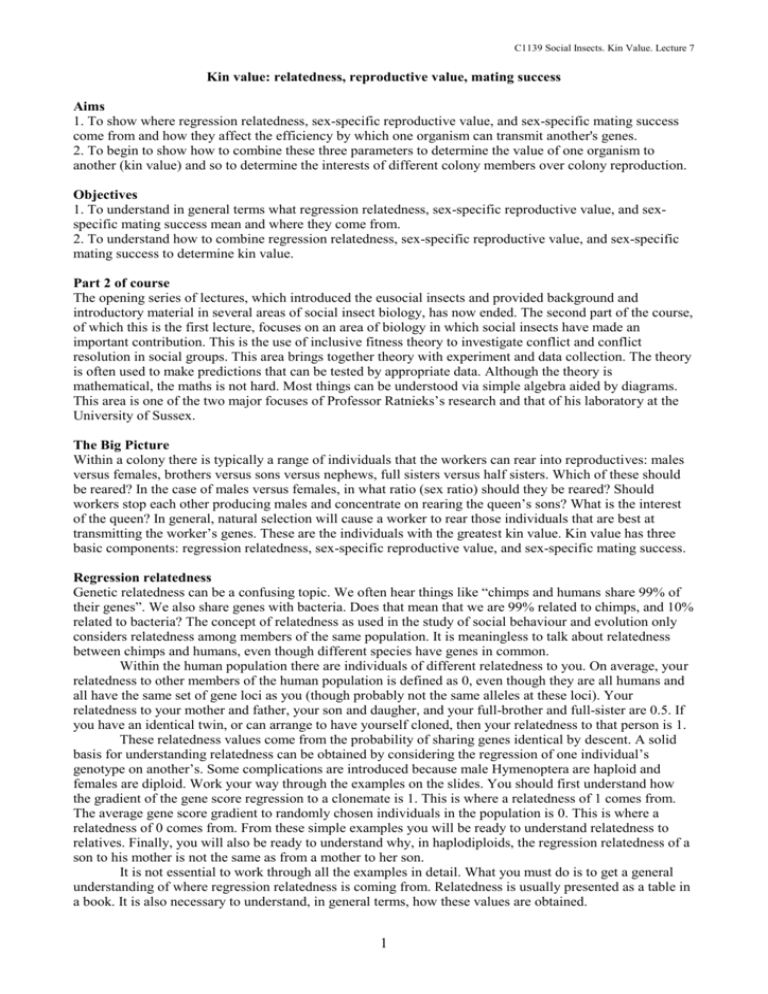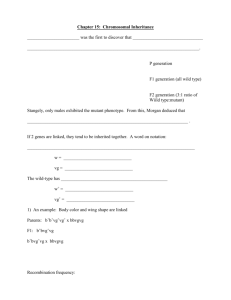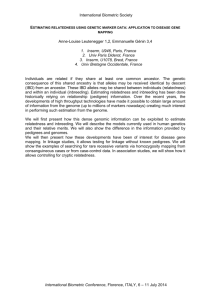
C1139 Social Insects. Kin Value. Lecture 7
Kin value: relatedness, reproductive value, mating success
Aims
1. To show where regression relatedness, sex-specific reproductive value, and sex-specific mating success
come from and how they affect the efficiency by which one organism can transmit another's genes.
2. To begin to show how to combine these three parameters to determine the value of one organism to
another (kin value) and so to determine the interests of different colony members over colony reproduction.
Objectives
1. To understand in general terms what regression relatedness, sex-specific reproductive value, and sexspecific mating success mean and where they come from.
2. To understand how to combine regression relatedness, sex-specific reproductive value, and sex-specific
mating success to determine kin value.
Part 2 of course
The opening series of lectures, which introduced the eusocial insects and provided background and
introductory material in several areas of social insect biology, has now ended. The second part of the course,
of which this is the first lecture, focuses on an area of biology in which social insects have made an
important contribution. This is the use of inclusive fitness theory to investigate conflict and conflict
resolution in social groups. This area brings together theory with experiment and data collection. The theory
is often used to make predictions that can be tested by appropriate data. Although the theory is
mathematical, the maths is not hard. Most things can be understood via simple algebra aided by diagrams.
This area is one of the two major focuses of Professor Ratnieks’s research and that of his laboratory at the
University of Sussex.
The Big Picture
Within a colony there is typically a range of individuals that the workers can rear into reproductives: males
versus females, brothers versus sons versus nephews, full sisters versus half sisters. Which of these should
be reared? In the case of males versus females, in what ratio (sex ratio) should they be reared? Should
workers stop each other producing males and concentrate on rearing the queen’s sons? What is the interest
of the queen? In general, natural selection will cause a worker to rear those individuals that are best at
transmitting the worker’s genes. These are the individuals with the greatest kin value. Kin value has three
basic components: regression relatedness, sex-specific reproductive value, and sex-specific mating success.
Regression relatedness
Genetic relatedness can be a confusing topic. We often hear things like “chimps and humans share 99% of
their genes”. We also share genes with bacteria. Does that mean that we are 99% related to chimps, and 10%
related to bacteria? The concept of relatedness as used in the study of social behaviour and evolution only
considers relatedness among members of the same population. It is meaningless to talk about relatedness
between chimps and humans, even though different species have genes in common.
Within the human population there are individuals of different relatedness to you. On average, your
relatedness to other members of the human population is defined as 0, even though they are all humans and
all have the same set of gene loci as you (though probably not the same alleles at these loci). Your
relatedness to your mother and father, your son and daugher, and your full-brother and full-sister are 0.5. If
you have an identical twin, or can arrange to have yourself cloned, then your relatedness to that person is 1.
These relatedness values come from the probability of sharing genes identical by descent. A solid
basis for understanding relatedness can be obtained by considering the regression of one individual’s
genotype on another’s. Some complications are introduced because male Hymenoptera are haploid and
females are diploid. Work your way through the examples on the slides. You should first understand how
the gradient of the gene score regression to a clonemate is 1. This is where a relatedness of 1 comes from.
The average gene score gradient to randomly chosen individuals in the population is 0. This is where a
relatedness of 0 comes from. From these simple examples you will be ready to understand relatedness to
relatives. Finally, you will also be ready to understand why, in haplodiploids, the regression relatedness of a
son to his mother is not the same as from a mother to her son.
It is not essential to work through all the examples in detail. What you must do is to get a general
understanding of where regression relatedness is coming from. Relatedness is usually presented as a table in
a book. It is also necessary to understand, in general terms, how these values are obtained.
1
C1139 Social Insects. Kin Value. Lecture 7
Notation: when writing regression relatednesses in symbols or in formulae use the notation b rd,i where r is
the recipient, d the donor, and i the colony or colonies or population you are referring to. For example bqw,i
could be shorthand for "the regression relatedness of the workers (donors) in colony i to the young queens
(recipients) being reared in colony i". Because of haplodiploidy bmale,female ≠ bfemale,male so it is important to
consistently put the donor second when donor and recipient are of different sexes. However, relatednesses
within a sex are the same when donor and recipient are switched. For example, bdaughter,mother = bmother,daughter.
Sex-specific reproductive value
Do not be confused by the term “sex-specific”. It simply means male or female. Sex-specific reproductive
value means the reproductive value of one sex versus the other. The concept of reproductive value comes
from R. A. Fisher and was originally applied within sexes. In particular, the reproductive value of a young
female is greater than that of an old female as the young female has more of her reproductive life ahead of
her. As a result, the young female will contribute more to the future gene pool of the population than will an
older female. However, we are not interested in the relative reproductive values of females or males of
different ages or sizes or qualities. Rather, we are interested in the relative reproductive values of ALL the
males versus ALL the females in the population in one generation to the future gene pool of that population.
It turns out that in eusocial Hymenoptera the females normally contribute more than the males to the
future gene pool of the population. This is because of haplodiploidy, not because of eusociality. In diploids,
both sexes contribute equally.
To understand this, imagine that it were possible to mark all the nuclear genes in all the females in a
population with red tags that remain on those genes and their copies from generation to generation. What
would we see next generation or in ten generations? In diploids, in the next generation both males and
females would have 50% red genes and it would stay that way in future generations. This is because a male
gets half his genes from his mother and half from his father, as does a female. (We will ignore sex
chromosomes and cytoplasmic DNA.) This shows that, in diploids, the sex-specific reproductive value of
ALL the males is the same as that of ALL the females.
If we do the same for haplodiploids we get a different result. Because a male has no father he gets
all his genes from his mother. Therefore, in the next generation all the genes in males are red. In contrast, a
female gets half her genes from her mother and half from her father. In the next generation the females have
half red genes. The red genes seem to be doing better. Over many generations the proportion of red genes
converges to 2/3 in both sexes. This means that the females contribute 2/3 to the future gene pool of the
population. Males contribute the rest, 1/3. The ratio of the sex-specific reproductive values of females to
males, VF/VM, is (2/3)/(1/3) = 2.
There is one other thing to consider, and it applies only to eusocial haplodiploids. If the workers
produce some or all of the males, then some of the males reared in a colony may carry the genes of the
queen’s mate(s). The workers are an in-between generation by which father males can pass on their genes
via workers’ sons. Imagine that all the males in the population are workers’ sons. (This happens in only a
few species.) The workers’ genes are half red as they get half from their mother and half from their father.
Therefore, the genes in the workers’ sons, which have no father, are also half red. If workers produce all the
males we get back to the diploid situation in which in one generation half the genes in both sexes are red. If
workers produce some of the males we have an intermediate situation. The ratio of sex-specific reproductive
values of females to males, VF/VM, is actually equal to 1 + p where p is the proportion of males in the
population that are queens’ sons. Across the eusocial Hymenoptera, p varies from close to 0 to 1.
The above can easily be explained using diagrams and equations to show how genes are transmitted.
These are shown in the lecture slides. One diagram is also pasted in at the end of these notes.
Sex-specific mating success
It is well known that different individuals can have different reproductive success. But here we are again
only interested in the average mating success of one sex versus the other. Males and females may, on
average, have different mating success. If 20,000 males and 10,000 queens are reared, then on average each
male will father half as many offspring as a queen. The mating success is, therefore, 2 to 1 in favour of
females.
The theory of sex ratios is mainly based not on the numbers of individuals of each sex that are
reared, but on the investment or allocation needed to rear them. In the above example, if the males and the
queens are equally costly to rear because they are the same size, then the allocation ratio in the population is
1 female to 2 male (1F:2M or 2/3 male and 1/3 female). If the males are only half as costly, because they are
2
C1139 Social Insects. Kin Value. Lecture 7
smaller, then the allocation ratio is 1F:1M or 50% male and 50% female. If 20,000 males and 10,000 queens
are reared in a population in one generation, and the males require only half as much food to rear, then the
mating success per unit of allocation (investment in rearing) is equal. Study the lecture slides to understand
things fully.
Kin value
The kin value of an individual or class of individuals (e.g., the males reared in a colony) is simply regression
relatedness x sex-specific reproductive value x sex-specific mating success. Consider two simple examples:
the kin value of the males (mother queen’s sons/workers’ brothers) and young queens (mother queen’s
daughters/workers’ full sisters) reared in a colony with a single queen mated to a single male.
Relatedness of workers to males, bmw
Relatedness of workers to queens, bqw
=
=
0.5
0.75
All the males are queens’ sons, VF/VM
=
2
(we can say VF = 2 and VM = 1)*
And the sex-allocation ratio is equal, MF/MM
=
1
(we can say MF = 1 and MM = 1)*
The kin value of a male is
The kin value of a young queen is
=
=
0.5 x 1 x 1
0.75 x 2 x 1
bmw VM MM
bqw VF MF
=
=
0.5
1.5
A queen has three times the kin value of a male. We will see what implications this has on queen-worker
conflict over sex allocation in a later lecture.
* note that the actual values of mating success and reproductive value do not matter; what matters is the
ratio of the values for females relative to males.
Suggested additional reading
Careful study of the lecture notes and slides is all that is required to understand this area. For those wanting
more you can read relevant sections in the books by Bourke and Franks (1995) and Crozier and Pamilo
(1996). Also the reference below. A long handout that goes into things in much greater detail is available on
request.
Ratnieks, F. L. W., Boomsma, J. J. 1997. On the robustness of split sex ratio predictions in monogynous social Hymenoptera.
Journal of Theoretical Biology 185: 423-439.
3
C1139 Social Insects. Kin Value. Lecture 7
Following Genes Across Generations
Eusocial or non-Eusocial
Haplodiploid
Eusocial Haplodiploid
All males are workers’ sons
All males mothers
’ or queens’ sons
4
Non-Eusocial Diploid
Both sexes have two parents









